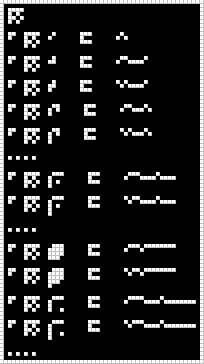#13. Modulate¶
Note
If you have any ideas or enhancements for this page, please edit it on GitHub!
Following documentation is a cooperative result combined from our Discord chat and numerous pull requests. Thanks to everyone who helped!
Image¶
This image was produced from the thirteenth radio transmission using previously contributed code.

This partly annotated version of the image was made using code from message #3.
Interpretation¶
The operator defined in this message, mod, is for converting numbers from a grid form into a linear-encoded form. The linear encoding appears to be a type of Variable-length encoding, with the following form:
Bits 0..1 define a positive or negative number (and signal width) via a high/low or low/high signal change:
01: positive number
10: negative number
Bits 2..(n+2) define the width of the following binary-encoded number via a unary-encoded number of length n composed of high signals ending with a low signal. The number width (in bits) is four times the unary encoding (i.e. 4 * n):
0: 0 [i.e. the number zero]
10: 4-bit number [i.e. 1-15]
110: 8-bit number [i.e. 1-255]
1110: 12-bit number [i.e. 1-4095]
…
The remaining bits, i.e. (n + 3)..(n + 3 + 4*n - 1), determine the number itself, in most-significant-bit first binary notation. Using the examples from this message:
0001: 1
00010000: 16
000100000000: 256
…
With this encoding, the number zero only requires three bits (i.e. 010), but arbitrarily large numbers can also be represented.
Decoded¶
mod
ap mod 0 = [0]
ap mod 1 = [1]
ap mod -1 = [-1]
ap mod 2 = [2]
ap mod -2 = [-2]
...
ap mod 16 = [16]
ap mod -16 = [-16]
...
ap mod 255 = [255]
ap mod -255 = [-255]
ap mod 256 = [256]
ap mod -256 = [-256]
...